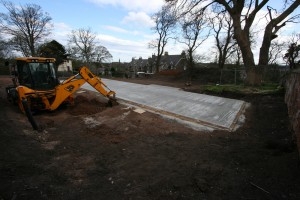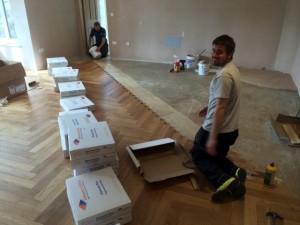Low Energy New build in Conservation area

Low Energy House
Introduction
With this prime site situated on Castle Terrace, Berwick upon Tweed nestling on the edge of the town conservation area, the GMC design team had both the client’s specification and the planning & building control teams to satisfy. The site is both double fronted and occupying trees with TPO attached.
The clients brief was to form a large family sized home with open garden to the south with the building shaped to offer as much privacy as possible. The client placed a huge emphasis on the building being as low energy as possible. Neil Craig from GMC spent some time in Germany with Passive house designers and contractors learning principals and construction techniques. This was to be ‘the’ low energy house the clients were looking for!
Client Specification, Planning, Building Control
With the client low energy specification, so high GMC design team advised on a Passive Has type fabric with very high insulation values and air tight construction to minimise the loss of any heat generated for the building. With air tight construction the building needs to have mechanical ventilation heat recovery system, so these services where planned at this stage.
Under floor heating was specified for the entire ground floor with radiators for the 1st floor. These heat emitters are served by a modern hybrid heating system backed with Air Source heat pump, mains gas boiler and solar thermal panels.
Through a pre-planning consultation with the local council the design team took the decision to bring on board a local qualified conservation architect with proven back ground in both conservation and landscaping for the design of the building. The planning team were very specific about the aesthetics of the building and the input from the architect would be vital to gain planning permission. As part of the planning permission considerable care was taken to protect the existing trees on site. The Client was very adamant about keeping the existing trees in place. A professional tree survey had been completed to assess the health of the trees. The GMC appointed engineer designed a sub structure suitable to direct loads away from the tree roots.
This was done by using mini piles supporting a concrete raft foundations which floats the house over the tree roots.
Building the low energy house
Ground works for low energy house
With an April start ground conditions were excellent for starting on site. The site was scraped and levelled with footings excavated ready for mini piles. Once the mini piles were in place GMC ground works team formed shutters for the concrete ring beam with metal reinforcement cage. Once this was in place the concrete raft was poured to support the ground floor.
Super-structure Fabric for low energy house
Ground floor – 140mm PIR Insulation with underfloor heating pipe work fixed covered with 80 Calcium sulphate screed.
External Walls – GMC timber frame manufactured in our own workshop since 1976! This frame is 140mm insulated with 140 frame-therm between the studs, 50mm PIR over the internal face. 25mm service void finished with 12.5 plasterboard and skim finish to the inside. The frame is finished to the outside with 9mm OSB for stability and a foil breather paper for both increased thermal performance and vapour barrier.
The whole of the outside of the building is finished in natural stone with dressed quoins and string courses at ground floor lintel level and the eves. The stone was chosen to complement the surrounding buildings with similar aesthetics.
Windows & Doors – Windows fitted are tilt & turn triple glazed & triple sealed for air tightness (0.7 u-value average). Gaulhofer are a registered passive house supplier. Front door supplied by Bereco with a u-value 0.9. The design detail around all the windows and doors are most import to achieve the air tight construction. These joints are sealed & taped.
Celling & Roof – Engineered truss system for the roof and open web-timber joists for the 1st floor joists. The open web-design allows all services to be housed within the first floor including 6’’ MVHR ducting. This minimises the need to breach the fabric which increases the risk of air leakage.
The inside of the both celling are wrapped with air guard building paper with all joints sealed to prevent air leakage. Services and cables with penetrate this membrane are kept to an absolute minimum with all penetrations sealed and taped. The loft is insulated with 500mm loft insulation where the first floor joist are insulated with 200mm to prevent un-wanted heat escape and sound insulation
The flat roof over the link is covered with a green roof which provides additional insulation and sound dampening.
Heating & Renewables for the low energy house
Glow Worm hybrid – forming the main part for the heating hot water for the home. The hybrid works with two heat supplies from both gas boiler and Air Source Heat Pump. The system controls constantly check the both sources and chooses the most efficient source to heat the property. The ground floor is served by zoned under floor heating network, while the up-stairs is served by radiators & towel rails. This was designed this was as the client preferred more temperature control for bedrooms and constant temperature for downstairs living areas.
Expel air MVHR – Every room in the property is served with a 5’’ duct which is either a supply or extract depending on the type of room. Kitchen/utility/bathrooms all have extracts where bedrooms and living rooms have supply ducts. The extracted air taken through a heat exchange, where the heat is extracted for the stale air and mixed with incoming fresh air which is distributed around the house. Using this type of system up to 90% of the heat in the property can be recovered rather than lost to outside.
Solar PV– The property has a 4.0kwp system installed on the roof, this system generates electricity during day light hours. The electricity is available for the property to use and any surplus electricity is exported to the grid. This system qualifies for a government incentive called the Feed in tariff (FIT). This provides the owner of the system with a payment for generating electricity for the next 20 years.
Solar Thermal – Connected to the 300 litre hot water cylinder, these panels heat up through the day by the suns radiation. The heat from the panels is transferred to hot water cylinder by flow and return pipes providing free hot water.
Wood burning stove – Fitted in the living room this 5kw Morso Stove is for spacing heating, burning logs for heat is classed as a renewable heat source. Ideal as an ultimate back up if there are any grid failures and off-grid heating is required for a short space of time.
Voltage optimisation – Fitted between the incoming main electricity supply and the home fuse board. The device lowers the voltage of the supply and optimises the supply. This allows all electrical devices in the property to run more efficiently.
Low Energy lighting – All light fittings are low energy with all down lighters either 1w or 4w consumption!
Integrated solutions for the low energy house
Data cabling CAT6 – the property has a central data point located in a cupboard in the utility. This is the control centre where everything in the property is controlled. All the TV points in the home served with data cables for internet connect for smart TV’s and data from a shared hard drive.
CCTV – The property is constantly monitored with a CCTV system storing images to cloud on-line saved for 3 months. Again this equipment is located at the central data hub for the property.
Building integrated Vacuum system – During the first fix, 2 ducts are run throughout the property with outlets positioned at strategic points for cleaning purposes. The ducts all run back to the vacuum unit which is located in the garage all the vacuumed refuge is stored in a bucket out-with the main house.
Audio & Visual – HDMI cables are run from the central data hub to all TV points, digital TV points are also run to each TV point in the house. This gives flexibility to each TV point, the option for each point to watch sky, Freeview, dvd or internet based media at the same time. The main living room doubles up as a cinema room with flush mounted wall speakers, concealed projector with 110’’ drop down projector screen also flush mounted.
Internal fittings & Finishing
As part of the contract GMC provided all the bathroom fittings & tiles from our own suppliers with our GMC trades fitting.
The kitchen, bedroom & play room fitted furniture is all from our own range again fitted by GMC personnel.
A Engineered Parquet flooring was laid throughout the ground floor, using flexible adhesive designed for heated floor slabs. With large ceramic tiles used for the kitchen & utility areas of the ground floor, these floor types are generally the best for use with under flooring heating.
The block paved drive was fitted using marshals tegula drive way products with colour scheme chosen to match the existing use of blue/grey roofing finish.
Summary
GMC are now off-site and the client has enjoyed their new home for over 8 weeks. The owners are taking reading and monitoring the property performance. The property shows that conservation and modern technologies can be used to provide a modern low energy home that meets the conservational aesthetics demanded by the surrounding area. This is the low energy house the clients were looking for!
Property data
Wall u-value 0.15
Ground floor u-value 0.12
Celling u-value 0.12
Windows & doors 0.70
Air test result 1.1 m³/h/m² at 50Pa
Solar PV 4.0kwp
Solar Thermal 300 litre
MVHR passive ventilation
ASHP 8.0kw
Wood burning stove 5.0kw
Voltage optimisation maximise efficiency
Low flow water fittings minimum water use
Start April 2013
Finish June 2014
Download the technical report here
[wpdm_file id=9]



